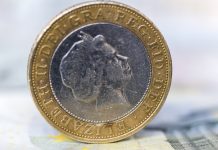The pound US dollar exchange rate finished the session on Tuesday marginally higher for the pound than where it started. In a session light on important economic data, investors digested President Trump’s new threat to North Korea, though predominantly they’ll be waiting for the Federal Reserve statement due later today.
Heading into Wednesday, the pound US dollar exchange rate was back trading above US$1.35, after slipping as low as US$1.3470 for sterling in the previous session. The rate remains 0.8% below its recent one year high of US$1.3619 reached on Monday.
| What do these figures mean? |
|---|
|
When measuring the value of a pair of currencies, one set equals 1 unit and the other shows the current equivalent. As the market moves, the amount will vary from minute to minute. For example, it could be written: 1 GBP = 1.28934 USD Here, £1 is equivalent to approximately $1.29. This specifically measures the pound’s worth against the dollar. If the US dollar amount increases in this pairing, it’s positive for the pound. Or, if you were looking at it the other way around: 1 USD = 0.77786 GBP In this example, $1 is equivalent to approximately £0.78. This measures the US dollar’s worth versus the British pound. If the sterling number gets larger, it’s good news for the dollar. |
The pound has been struggling to maintain positive momentum over the past few sessions. At the end of last week the Bank of England (BoE) inspired a rally by unexpectedly hinting that it could start to raise interest rates in the coming months. However, BoE Governor, Mark Carney, dampened hopes of any extensive action by the central bank. Carney announced that any rate rises would be gradual and limited. This dashed market hopes of several quick interest rate hikes, which caused the pound to drop.
| Why do raised interest rates boost a currency’s value? |
|---|
| Interest rates are key to understanding exchange rate movements. Those who have large sums of money to invest want the highest return on their investments. Higher interest rate environments tend to offer higher yields. So, if the interest rate or at least the interest rate expectation of a country is relatively higher compared to another, then it attracts more foreign capital investment. Large corporations and investors need local currency to invest. More local currency used then boosts the demand of that currency, pushing the value higher. |
Today the pound could come under renewed pressure if retail sales figures disappoint. Analysts are forecasting that UK retail sales numbers will stagnate in August as households struggle to adjust to a tougher economic climate. Higher prices and lower wages could keep the consumer from hitting the high street, which is bad news for the economy.
| Why does poor economic data drag on a country’s currency? |
|---|
| Slowing economic indicators point to a slowing economy. Weak economies have weaker currencies because institutions look to reduce investments in countries where growth prospects are low and then transfer money to countries with higher growth prospects. These institutions sell out of their investment and the local currency, thus increasing supply of the currency and pushing down the money’s worth. So, when a country or region has poor economic news, the value of the currency tends to fall. |
Trump issues threat to North Korea in debut UN speech
Demand for the dollar dropped after US President Donald Trump used his first appearance in front of the UN general assembly to issue a dark warning to North Korea. Up until now, the US President has remained surprisingly quiet over the recent provocations from Pyongyang. However, in his debut appearance he didn’t hold back, vowing to “totally destroy” the rogue nation should it be necessary.
Aside from North Korea, Trump also focused on his “American First” values, with an agenda of nationalism over globalisation. Dollar investors believe that an inward-looking approach isn’t beneficial to the US economy and, as a result, the US dollar sold off.
Investors will now focus solely on the US Federal Reserve statement following the Fed’s monetary policy meeting due later today. Any changes to the current forecast for interest rate rises could result in volatility for the buck.
|
This article was initially published on TransferWise.com from the same author. The content at Currency Live is the sole opinion of the authors and in no way reflects the views of TransferWise Inc. |





